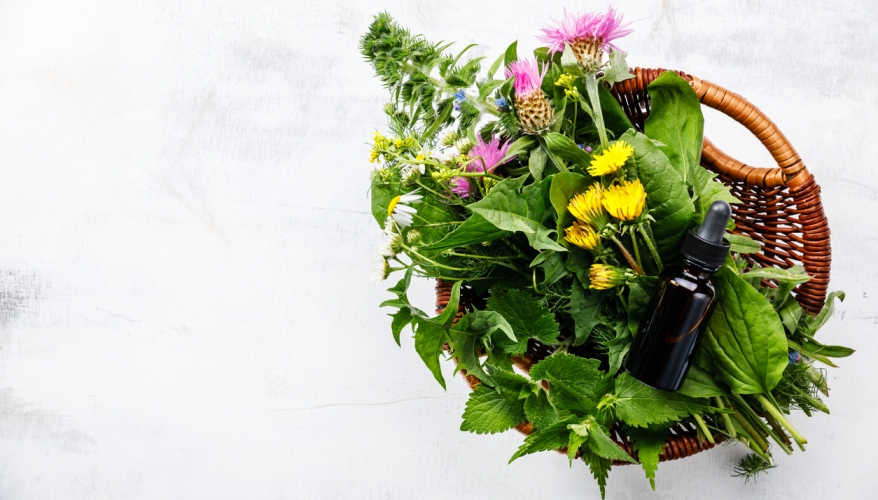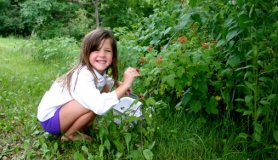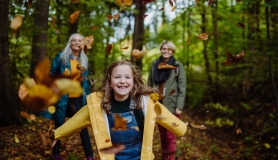My kids are pretty wild. they are still young enough to get into all sorts of mischief and most of this happens in the (somewhat tamed) wilds around us. For me, the real beauty of this curiosity to explore nature’s gifts comes when they find medicines hiding in the hedgerow or hanging wantonly from a tree in juicy glory.
Plants with healing or medicinal properties are all around us and as an herbalist I like to use what is around to inform my herbal practice, especially with my children. It can be a scary experience when our children get sick or injured, but there are a lot of herbal medicines that can be used safely and effectively in an age where antibiotics are over-prescribed and parents feel disempowered about how to help their children.
Getting outside
As my children explore the countryside, I am also trying to “rewild” myself by allowing more time to just be outside and not worry about the things I “need” to do. Luckily for me, my job entails being outside and collecting medicines but anyone can do this for learning or pleasure. When I lived in London I used to walk around Hampstead Heath or down by the canal to see what was growing around me.
With my children, we venture up onto the commons that make up much of the land near our home, and find treasures in the form of dog rose, eyebright, nettles, or goosegrass. Down along the canal path we’ll see meadowsweet, agrimony, plantain and figwort. In the woods we hunt around for medicinal mushrooms, horse chestnut and elderflower. In people’s gardens we spot marshmallow, chamomile and marigold. Along hedgerows and banks we’ll unearth medicinally rich roots. There is a veritable treasure chest of medicines available to us all if we know how to make and administer them.
Using with confidence
Having been trained in herbal medicine, I am confident to use plants to treat myself and my children alongside the patients in my practice but I feel strongly that it is every person’s right to know how to use wild medicines with confidence. I feel our connection to herbal medicine has been lost through our reliance on modern medicine and practitioners who often make decisions for us rather than with us. At the apothecary, I teach Wild Medicines for Wild Kids in order to give parents and carers a sound basic knowledge of how to use some common medicinal plants when their children are poorly or injured.
Getting started
So, where do you start? Well, chamomile (Matricaria recutita) is the first plant medicine I used with my children. It is commonly found in gardens and so easy to grow in the garden or in pots. The flowers are harvested and dried for tea or made into a tincture or flower water (hydrosol).
Calming chamomile
I bathed my first born in a bath made up with a strong infusion (2-3 teaspoons of dried chamomile steeped in a large cup of boiled water for 10 minutes) of chamomile which I had dried earlier in the summer. Chamomile is a gentle but effective anti-inflammatory and antiseptic, cooling heat in the skin which had arisen when my son, Lorien’s skin started to react to the dry air environment in which he found himself following birth.
Internally, taken as a tea, chamomile can help to calm nervous children and ease a tight tummy. If given in the right way the child will tolerate bitter tastes such as chamomile. If the child is slightly older and used to sweet drinks such as juice, honey may be added to ensure the medicines are taken.
Easing colic
When my daughter, Luma, started crying and writhing a little in the evenings as a babe, I would drink several cups of chamomile, fennel and lemon balm throughout the day – all of which we had harvested the previous summer and carefully dried to preserve the volatile oils. As she was breastfed she also gulped down these herbs and her colic abated. These are herbs which are common to cultivated gardens and if grown organically can be a fantastic connection between the civilisation of home and the wilds further afield (unless you happen to live in the wilds themselves). They can also be given directly to children as a tea. Fennel and lemon balm can also be easily grown and are quite prolific!
Chamomile is also the first thing I think of if my children look like they might be getting a cold. A warm infusion with honey is very soothing and settling whilst working to prevent the cold virus taking hold.
An antiviral syrup
When our children look like they are getting a cold, as well as our “Magic Tea” (chamomile, catnip, yarrow and rose with a little honey) they get elderberry rob. This wild medicine is an incredible antiviral syrup of yumminess. 17-month-old Luma squeals delightedly if she sees the brown bottle we have ours stored in. Lorien absolutely loves going out and spotting elderberries though sometimes I think he may just be after the blackberries that are around at the same time so we also make blackberry rob which, full of vitamin C, goes on his toast.
Taking what you need
We are ethical in our approach to wild-crafting and take only what we need and what the area we are picking in can give, for example we will always leave at least 2/3 of what we can see. That said, last year it was not so easy to find many elderberries as the birds had stripped what little there was around us and a lot of the trees had not produced much. We had the added problem of having harvested a good bunch of elderflower from our own tree so we really had to hunt for our berries!
Long afternoon walks on sunny autumn days kept my children happy, wild and fit with the reward of a basketful of berries at the end. Getting into the wilds seems to bring out the best in myself and my children. Bringing the wilds back into the home to create medicinal treats is a bonus. That said, just spending time outside is also really helpful – whether in your garden looking at dandelions or down by the local canal or river or green area. There are always herbal medicines to be spotted.
The medicine chest
Elders (Sambucus nigra) were once referred to as the “medicine chest of the country people”. The delicious berry which is fantastic for colds and coughs does not, however, outshine the medicinal potential of the flower. Beautifully sweet smelling after spring or early summer sunshine, the elderflower may also be used for children.
A tea will help dry up runny noses (rhinitis) from colds or hayfever. It can be mixed with yarrow and peppermint to create a wonderful tea that alleviates feverishness and aches that come with cold viruses.
“There are a lot of herbal medicines that can be used safely and effectively in an age where antibiotics are over-prescribed”
Dealing with fever
Yarrow (Achillea millefolium) is an ally. Those feathery leaves you see amongst the grass in a basal rosette or growing on the strong stems of yarrow are wonderful diaphoretics. They help with fever. Each parent must know their own mind and how much care they are willing to give with or without medical assistance but for me teaspoons of yarrow tea given to my children when they have had fevers in the evenings have helped so much that on only two occasions did the fever continue. One fairly high fever Lorien succumbed to as a baby was broken with yarrow and chamomile baths and close skin contact with me.
Bathing with plants
Warm baths are an easy and very worthwhile way of using medicinal plants and can help with conditions such as colds and coughs (yarrow, chamomile), anxiety (chamomile, rose, limeflower), skin conditions (rose, lavender, oats), headaches (lavender), tummy aches (chamomile), and a whole lot more. Put some herbs in a sock and tie the end and let it infuse as the bath runs or make a strong infusion and add it to a bath.
An oil for earache
For earache, a simple oil can be made from a mullein (Verbascum thapsus). Just macerate the dried herb in an good quality oil for 2-3 weeks. Strain and bottle. Last summer we found lots of mullein flowers in the fields near us (which we knew to be unsprayed) so we picked the little yellow flowers and dried them before making our oil. I have used it on myself as well as the children, warmed a little before application.
The healing rose
One wild herb both in temperament and environment is the dog rose (Rosa canina). She grows as she wills, her thorns warning off threat and little fingers. While my children come with me to pick rose petals and hips, they rarely remain picking for long, preferring to play nearby while I harvest the delicate petals and my clothes grapple with the thorns.
Rose provides a lot. The wild dog rose is wondrous. Cooling, antiseptic petals with more goodies than green tea or rooibos, make this overlooked native rambler a wonderful addition to home remedy kits. There are so many uses for rose I cannot list them all but one fantastic remedy for wild kids is as a herbal plaster. Should your child cut his or her finger, a rose petal poultice or plaster can really help. The petals are anti-infective and soothing, they will help minor cuts and are super fun for kids. They may be tied on with plantain leaves wrapped around. Of course make sure the petals are clean and above dog pee height. Rosehips are so full of vitamins and other nutrients that it seems a crying shame fewer and fewer people are taking advantage of what is essentially a free food. Food is our basic medicine and kids will readily sup rosehip syrup or rosehip syrup tea.
Scrapes and bruises
My kids fall over a fair amount as they scramble about trying to pick berries or climb, and while there aren’t always rose petals around, there is plantain (Plantago lanceolata or major) and dock (Rumex spp.) for much of the year. To treat scrapes, bruising, and stings, the leaf of plantain (or dock) needs to be mashed else it won’t really help. Pound it in clean hands or as a last resort chew it (saliva is a bacteria risk) and apply it mushed up so the juices can get to the affected area. Lorien is very vocal if he gets stung but once the plantain poultice is on and tied by another plantain leaf tucked in a sock or sleeve, he is happy.
There are many more wild plants that can provide medicine that children can take when needed such as dandelion, hawthorn, burdock, bilberry, nettle, self-heal or lime flower. Learning about these medicines is such a valuable asset for the modern parent who wants to be in the wilds or bring the wilds into the home.
Always seek a qualified practitioner if you have any doubt whatsoever about your own or your child’s condition. Find your local medical herbalist and have a chat to see what they can offer; many offer courses as well as consultations. Go out and find some medicines!
Amy built her own apothecary where she practices in Gloucestershire. She is mother to Lorien, three, and Luma, one.
RECIPE FOR ELDERBERRY ROB
- Harvest a good amount of elderberries (preferably away from the road or sprayed areas), then juice them through a wine-press, sieve, jellybag or make-shift jelly bag such as a clean t-shirt that you don’t wear anymore.
- Strain the juice once more to make sure there are no bits and then pour into a heavy-bottomed pan and heat to reduce the liquid until it is a syrup (at a temperature of around 80ºC). Once it is thick you need not add anything but should you choose you can add honey or another tincture such as echinacea or elecampane.
ROSEHIP SYRUP RECIPE
- 2lbs rosehips; 4.5l water
- 1lb sugar (you can substitute honey or other sugary preservative)
- Put the rosehips in a food processor to mash them up a bit then add to 3.5l of the water. Simmer for 20 mins and let stand for 10 minutes. Strain. Bring the remaining water to the boil and then add the rosehips and simmer once again for 20 mintues and let stand for 10 minutes. Strain.
- Combine the liquids and reduce until you have around 1.5l then add the sugar and wait until it is dissolved, stirring occasionally. Bottle. I like to experiment with this. I often add the juice of a lemon and gauge the amounts by eye. I also sometimes substitute honey for sugar or let the infusion stand overnight.
Want to know more?
Visit wildapothecary.com to find out about Amy’s workshops and courses







